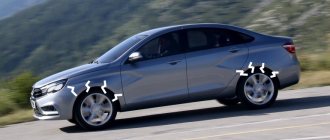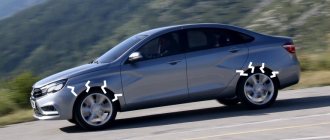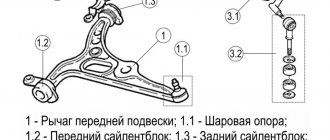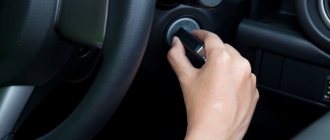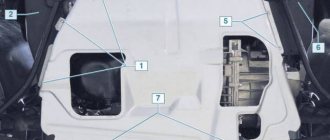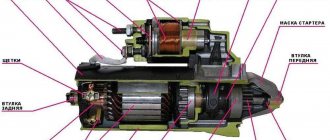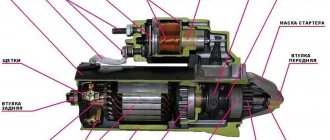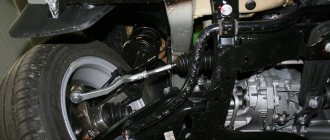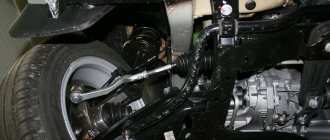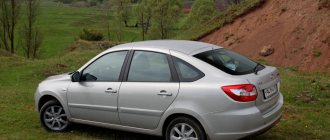We eliminate the squeaking noise from the rear, the reason is in the handbrake cable of Lada Granta and Kalina
From the very beginning of the production of the Lada Granta and Kalina 2 models, owners began to encounter creaking and sometimes knocking in the rear of the car. If the suspension diagnostics do not reveal any problems, pay attention to the handbrake cable. Due to the poor placement of the fasteners, the handbrake cable can not only creak, but also rub the bottom down to the metal.
If you look at a Lada Granta or Kalina car from below, you will notice that the handbrake cable runs along two sides of the body and has two attachment points on each side. The cable does not sit securely enough in the fastenings, which is why it rubs against the body and after 2000 km can wipe the bottom down to metal. The process is accompanied by a creaking or knocking sound. A similar problem can be found even on modern Grants or Kalinas produced in 2021.
Comments • 49
Beautiful Pavel, I had the same problem at 100 thousand miles. I did as you showed, the creak disappeared!!
There are already a lot of comments about music, I join. I only understood from the comments what was poured into the syringe. Well, in general, thanks, we’ll give it a try.
What kind of liquid should I put in there? Oil ? Nigrol?
Thanks to the author of the video. I spent a long time looking for what was creaking, the fault was the support bearing, after watching this video, it squeaked like mine, even on the same wheel. I went and bought a syringe of 5 cc (too bad the needle was thin), and injected probably 1.5-2.0 cc of a “faith” injection. Oh my god it doesn't squeak anymore. But I still ordered reinforced ball joints and will change them. The car (Kalina 2, produced in 2021) covered 70,000 km. Once again, respect and respect to the author.
How many cubes should the dose be?
Idiot, turn off the music
I have a 2021 Granta Fl, mileage 3000, the chassis is already creaking, what the heck..
@Egor Kuznets, I went for a ride today, including several times driving along the fucking path from the house to the asphalt and back. The good thing about silicone is that it retains normal softness during temperature changes. I’ll ride like this for now, if it creaks again, then I’ll come up with something else. I was very surprised by the fact that I didn’t really have to tighten anything in the suspension and chassis. I remember the new seven was turning almost the entire bottom.
@Vadim Kryuchkov the handbrake cable can be pulled out of the bracket, where it rubs against the body. And secure with zip ties. People do this right away. I tried to put rubber bands on it, but after a heavy rain it started squeaking again.
@Egor Kuznets, there is no market, our concern is everything. Well, okay, when I took bucket 21074 15 years ago, well, there didn’t seem to be much to ask. A tractor is a tractor, although unlike the Soviet-era sevens, the new one turned out to be just brutal crap. And here it’s like it’s not a big deal. After 15 years, it’s like you’ve gone to heaven. Everything works, there are brakes, a heater, the steering holds, as if you were driving on rails. A song, not a car. And I drove a hundred kilometers and I started listening to bugs, crickets, spiders. I made noise from everything, from seven to ten, otherwise it’s impossible to drive. The noise from the wheels is hellish, especially in winter on asphalt. I’ll make noise with this one over time, but the car was bought in principle so that for five years it would be stupid to pour gasoline and change the oil, and not crawl under it. My mileage per year is less than 10 thousand now. That’s why I tensed up when the new car started creaking. Eliminated this creaking and croaking yesterday. I drove it into the pit and stretched everything that was below and that could be pulled under. I inserted spacers from food-grade silicone hose into the brackets holding the handbrake cables.
@Vadim Kryuchkov and regarding quality, this is a small matter, easily resolved. Any car requires love and care.
@Vadim Kryuchkov you’ve gotten really crazy here. Don't worry, it won't fall apart. For 6 years I have been driving Kalina 2 on such roads that after overloaded trucks in the heat, all that remains is asphalt. It’s really a pity to ruin a foreign car on such roads for 1.5 - 2 lamas. And it’s tall and doesn’t catch on the bottom.
You turn up the music in the car and not in the video, and the squeaks will disappear
How to eliminate a squeak in the rear of a Lada Granta
The source of squeaks is the handbrake cable, which goes to the rear brake mechanisms along the car body. In the area of the rear arches, the cable lies in hooks on the body; it is in this place that the handbrake housing rubs against the body and makes an unpleasant sound. There are several ways to solve the problem. I've personally used a few and come to some conclusions.
First: lubricate the cable attachment points with lithol. Not the most effective, because After a while, the lubricant is washed out and the squeak appears again.
Second: use a hammer to clamp the cable more firmly in the eye. The method is effective, but the creaking still returned after six months. You also increase the contact patch between the cable and the body, which can increase body chafing.
Third: remove the cable from the eyes. The most effective way. The cable no longer touches the body, 100% solution to the problem. At the same time, the cables do not sag much, the chance of them catching anything is extremely minimal.
Through personal experiments, I came to the conclusion that the third method is the simplest and most effective.
Creaks and knocks in the front suspension of the Lada Granta: causes and diagnostics
Comfort when driving a Lada Granta car consists of many factors, one of which is the operation of the front suspension. Knocking, noise, and “breakdowns” of the suspension also affect traffic safety, so timely diagnosis of breakdowns of this unit is simply necessary. It is better to carry it out at a service center, but some faults can be identified yourself.
Conclusions that suggest themselves
As you can see, there are plenty of reasons for the occurrence of third-party noise in the front suspension area. However, most of them do not pose any danger to the further operation of the vehicle. Despite this, experienced auto mechanics advise carrying out a full diagnosis of all elements of the chassis when noise occurs in the suspension area, because only during this process can the condition of all component components be fully assessed.
Restoring the front suspension is not difficult, so any car owner can independently carry out repair work, during which damaged parts will be replaced.
Probable causes of suspension malfunction
View of the front suspension “from under the wheel”
The unpleasant creaking of the front suspension of the Lada Grant, “breakdowns” in its operation lie in the malfunction of the elements of this component of the car. Conventionally, they can be divided into two groups: the shock absorber strut with its contents and all the rest. The reason for separating the strut into a separate category is due to the increased load on it: it simultaneously performs the function of an upper arm and dampens vertical vibrations of the wheel.
The main causes of malfunctions of the telescopic stand include the following:
- Loosening of the attachment of its upper support to the supporting body.
- Destruction of the rubber buffer.
- Liquid leakage from the shock absorber, scuffing on its rod, damage to the chrome coating of the rod.
The shock absorber is leaking (needs replacement)
In the photo: lower lever assembly with ball
Damage to the ball joint is also possible, usually caused by an overestimated service life or the installation of a substandard part. Worn rubber bushings in the stabilizer and braces will also affect the smoothness of the suspension. Breakage of the main spring is unlikely, but natural wear or installation of a non-standard model can cause a loss of elasticity of the suspension as a whole.
Self-diagnosis of faults in the front suspension
There are several explanations for even one symptom of a breakdown, so it is better to identify the true cause of the malfunction at a bus station.
The following groups of signs of deviations in the operation of the front suspension can be distinguished:
- Spontaneous deviation from straight-line movement, “yaw” of the machine.
- Noises, knocks, “breakdowns” when driving on uneven roads.
- Reduced service life of suspension elements, their rapid failure.
The paint on the stand has come off and the stand has begun to rust.
The first group usually includes malfunctions of the stabilizer. You can visually inspect the entire suspension and, if there are no signs of dents or deformations, then it is worth checking the setting of the toe-in/camber angles of the front wheels. Externally, their deviation is observed in the uneven wear of the tread of the front wheels, but it will take some time for the tires to wear out.
There is a chance to detect this failure by ear: when entering a turn, you will hear the creaking of rubber, and the steering wheel usually does not return to its original position on its own.
A creaking sound in the front suspension is one of the temporary malfunctions of a Lada Granta car if it is caused by operating the car on a polluted or sandy road. In this case, sand particles may get into the rubber seals (silent blocks) of the stabilizer or braces. After washing the noise disappears.
The “couldn’t be simpler” suspension is just a plus.
The suspension is “simple to the point of disgrace”, a crab, a strut, a lower ball, two silent blocks - and that’s it, that’s all its capital.
After any work that involves disconnecting the hub from the strut, it is necessary to do a wheel alignment. As a last resort, you can try using a chisel to make marks on the strut and on the camber bolt (it's on top).
Knocking noise when driving over uneven surfaces
Knocking in the suspension when driving over uneven surfaces is also uncharacteristic: the Lada Granta, although not an off-road vehicle, is quite capable of overcoming small bumps. Typically, knocking noises occur when fasteners are loosened, nuts are tightened, or the ball joint or shock absorber strut is worn out.
If the service life of the suspension elements is too short, there are usually two reasons: poor quality of the parts used or an overly dynamic, aggressive driving style.
It is also worth paying attention to the compliance of the front wheel rims and tires themselves with those recommended by the manufacturer.
Lada Granta suspension device
Front suspension device (diagram)
This car uses an independent suspension with one lever, to which the lower part of the steering knuckle is screwed. Its top is mounted to the shock absorber strut, the operation of which differs from many similar units on domestic cars. When you turn the steering wheel, the fist with the shock absorber strut and the spring placed on it rotates. The shock absorber auger, screwed through a bearing to the upper strut support, remains stationary.
The ball joint provides flexible articulation between the steering knuckle and the suspension arm. The camber angle is adjusted traditionally for front-wheel drive versions of VAZ cars - with a nut with an eccentric on the main shock absorber strut, at the point where it connects with the steering knuckle. The suspension is kept from directional fluctuations by a common anti-roll bar and braces on both sides of the suspension.
Details in the photo
All suspension elements are in the photo below
- anti-roll bar;
- rubber-metal joint of the transverse arm;
- shock absorber strut;
- stretching;
- bracing bracket;
- nut securing the brace to the bracket;
- shock absorber strut ball joint;
- roll joint;
- wishbone;
- stabilizer bar mounting bracket
Causes of noise when turning the steering wheel
If any malfunctions occur, it is better to immediately determine the cause of their occurrence. If you hear a grinding noise when turning the steering wheel, the Grant needs repair. The steering design of the entire modern Lada line differs little, which means the causes of the malfunction will be similar:
- the outer hinge is worn out;
-high axial play of the wheel (bearings on the front wheels are heavily worn or the hub nuts are loose);
- wear of the rubber support element, bearing of the telescopic strut support
- loosening the bolts that secure the wheel
- the bolts securing the stabilizer bar to the body have become loose
- loosening of the steering wheel, steering column bracket, steering mechanism.
Weak points of the suspension
In wet weather it is not always possible to see a defect in the shock absorber strut
If you carry out independent repairs, for example, replacing a ball joint, then you must carefully tighten the fastening bolts. There are no through holes in the steering knuckle to which the support is attached: the bolt is screwed into the knuckle itself. Excessive tightening force may cause the bolt to break. A knock in the front suspension may also occur for this reason.
For reliable and long-term operation of the suspension, it is necessary to comply with the speed limit of the machine stated in its technical passport. Also, regular maintenance will help eliminate the appearance of noise, knocking and deviation from straight-line movement.
I noticed an incomprehensible knocking noise coming from the right side of the front of the car. Since I don’t have a pit at home, I went to the service center, where the guys said that my car’s ball joint had fallen off. Not the most expensive of car parts. The replacement also did not require large financial investments.
A knocking sound appeared when going over bumps on the front left wheel; also, when braking, the steering wheel pulls to the left, and when accelerating, to the right. We found out that the tie rod end has play on the tie rod side.
Main shaft bearing
If there is a hum under the car, it may be caused by the input shaft bearing located in the gearbox. It also tends to wear out over time. Diagnosing this breakdown is quite simple. To do this, you only need to switch to neutral gear while driving. If the disturbing sound disappears, it means that the specified bearing is faulty and must be replaced.
It is noted that the higher the vehicle speed (during acceleration), the louder the buzzing will be. Replacing the bearing must be carried out only in a car service; replacing it yourself is hardly possible due to the complexity of installation, dismantling and work associated with disassembling the gearbox. In addition, special tools and equipment are often simply needed.
How to eliminate squeaks on a Lada Granta Liftback: recommendations from an expert
Creaks are present even in the basic configurations of the Lada Granta Liftback, despite being equipped with noise and vibration insulation. This causes significant discomfort to the driver while driving.
Eliminating squeaks is not an easy, labor-intensive, and costly procedure. Not all owners willingly agree to do this in a service station. In order to save money, car enthusiasts practice doing noise reduction with their own hands.
Read below about how to do this on a Lada Granta Liftback.
What material is used to eliminate squeaks?
- bitoplast;
- anti-creak
Few owners know the use of each material; they are often considered identical, but this is not so.
Anti-creak is often called “madeline”, after the same name of the component included in the main composition. Madeline is a thin material, not intended for noise and vibration insulation. Suitable only for eliminating squeaks.
Bitoplast - also known as “Shumka”, has a thick fiber structure, is used primarily to reduce noise and vibration levels. It is not used as an anti-skripin. Although they sell it in stores as a universal remedy, which is fundamentally wrong.
Eliminating squeaks in the cabin
Upper side trims
- Carefully pry up the plastic cover and remove it.
- We glue several strips of madeline onto the metal stand.
- We fix the laid electrical wiring with insulation.
- We press the overlay. If you don’t want to glue it to metal, apply Madeleine to plastic.
By analogy, we remove the squeak on the right pillar.
Torpedo in places where fasteners are fixed
On the left and right sides, the torpedo is pressed with two screws under a cross-shaped bit. The “noise reduction” process is as follows: unscrew the screw, place a plastic washer (ring) under the support. The height should be in the range of 0.3 - 0.5 mm. Exceeding the height does not guarantee a tight fit of the torpedo in its normal place.
We repeat a similar procedure on the torpedo mount on the right side.
The front part of the deflector grille, radio, stove heater speed controller
The procedure involves removing the plastic trim from the front of the torpedo and gluing Madeleine strips around the perimeter. In this case, we do not touch the inside of the panel, where it is necessary to additionally glue the bitoplast.
We do not recommend fitting it “with glue”, since if removal is necessary, the structure will not be removable.
Internal “stuffing” under the dashboard
To remove extraneous noise, you will need to completely dismantle the front instrument panel, remove the wiring blocks, disconnect the stove heater control levers, and deflectors.
- After the panel is removed, we proceed to pasting the back of the torpedo with bitoplast, wrapping the levers of the drive mechanisms in an insulating layer.
- We put the electrical wiring in a fireproof corrugation and tighten it with clamps.
- We assemble the structure in reverse order.
Door card
We disassemble the door trim if noise and vibration insulation measures were not taken when installing the acoustics. If the work was carried out at a service station, then there will be no such problem.
We glue madeline in the form of strips around the perimeter of fixing the acoustics. If necessary, cut out strips along the outer perimeter of the door card.
Trunk lock fixing shackle
There is only one recommendation - replace the bow with a new one, since this is a manufacturing defect.
Side pads made of plastic
- Use a plastic object to pry up the plastic casing and remove it.
- We glue anti-squeak strips to the inside around the perimeter.
- We install it in its original place.
If the lining is clearly deformed, we replace it with a new one, since gluing it on Madeleine will not give a positive result.
Reviews
| № | Positive |
| 1. | Vitaly: a year has already passed since the purchase of Granta, I spent the night on the street in winter, there is no creaking. The dashboard is quiet. |
| 2. | Gennady: There are no complaints about the torpedo, it doesn’t make noise, it doesn’t creak. I installed acoustics at the service center, apparently it was a hack job. Two months later, the door card on the left side began to make noise. I put Madeline on it and it doesn’t make any noise. |
| 3. | Vasily: I heard from other owners that the panel creaks. I can’t confirm that it fits evenly and is not deformed. |
| 4. | Kirill: when buying a car, the dealership recommended a torpedo care product. I apply it systematically, cover it in the sun, there is no vibration. |
| 5. | Vladimir: after buying the car, I immediately retightened the instrument panel and lubricated it with silicone. No complaints, no noise, no knocking. |
| Negative | |
| 1. | Victor: No matter what I did with the torpedo, it’s constantly making noise. In the spring I plan to completely disassemble and glue it with rubber. Factory quality is poor. |
| 2. | Ignat: drove it one winter, after which the tidy began to rattle. I disassembled it, put in plastic inserts, and the extraneous sounds were eliminated. |
| 3. | Ivan: negative review about the factory assembly of the Lada Granta Liftback. Already in the third month of use, the panel began to rattle. |
Conclusion The human factor is present everywhere, including with the assembly of a torpedo on the Lada Granta Liftback.
It will not be difficult for the owner to tighten the plastic fastening points with a screwdriver within half an hour. It is important to follow the manufacturer's recommendations regarding protection from ultraviolet rays. Special rolls of foil are available for sale for this purpose.
In most cases, panel deformation is caused by violation of operating rules by the owner of the equipment.
